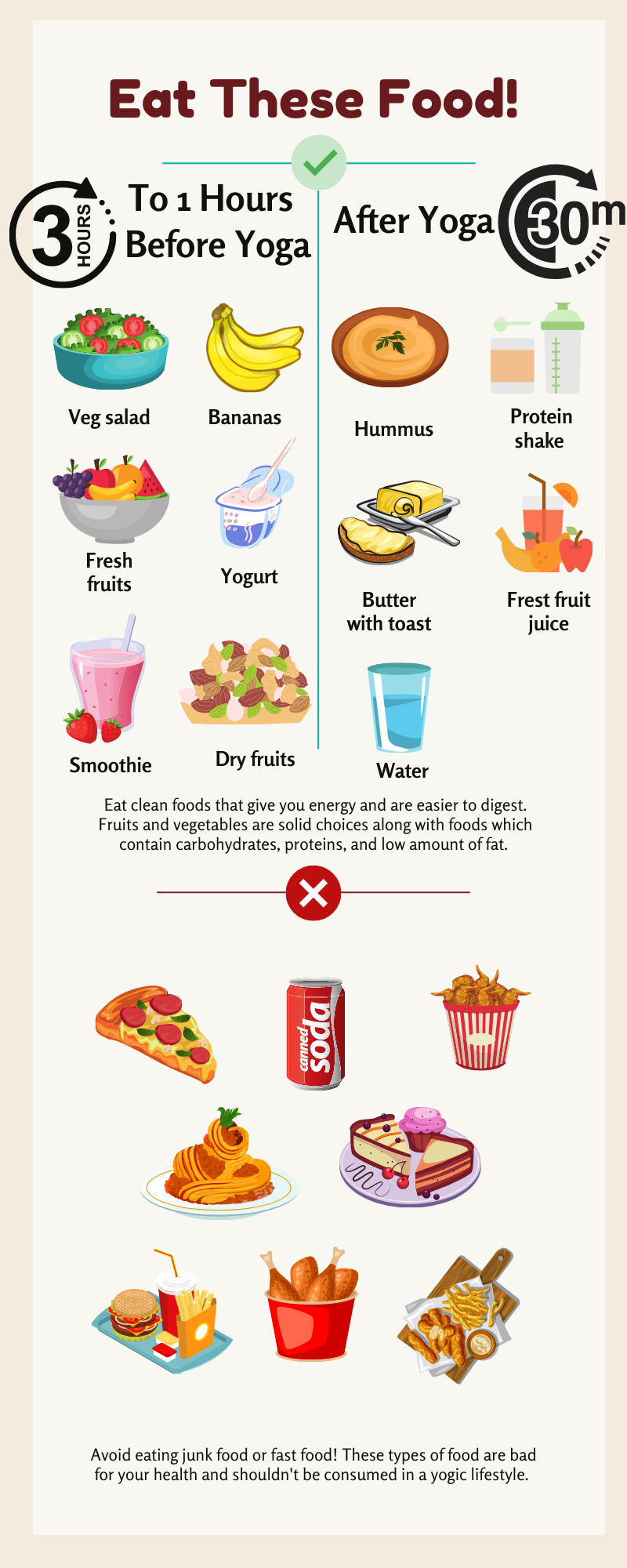- The nutrients
- Yoga in empty stomach
- Before yoga foods
- Foods to avoid
- After yoga foods
- Time to drink water

It is often advised not to exercise immediately after a heavy meal. Instead, eating a light meal a few hours before any form of physical activity is recommended.
But why is there so much emphasis on meal timing before exercise, especially yoga?
While traditional yoga may not always feel as intense as a gym workout, many yoga poses involve bending, twisting, and compressing the abdomen. Performing these movements on a full stomach can cause discomfort, bloating, or even nausea.
Many people also experience the discomfort or embarrassment of stomach noises during quiet yoga sessions. These issues can be avoided with the right food choices and timing.
This article explores what and when to eat before and after yoga. It covers:
- How long to wait after eating before yoga
- When to practise yoga on an empty stomach
- What foods to eat before yoga
- What to eat after yoga for recovery
- Foods to avoid before and after yoga practice
Before going into specific food suggestions, it is important to understand the nutrients in food and why they matter. Knowing what your body needs can help you make better dietary choices to support your yoga journey..
Understanding nutrients: What to eat before and after Yoga
Knowing what to eat before and after yoga is essential for supporting your energy levels, performance, and recovery. Every food is made up of nutrients, and each nutrient plays a unique role in the body.
Each nutrient has a specific function in relation to yoga practice. Choosing meals that contain the right balance of nutrients is recommended for both pre- and post-yoga nutrition.
Depending on the type of yoga you practise, your body may need varying amounts of carbohydrates, proteins, healthy fats, and water. These elements, when combined in the right proportions, help to build and maintain a healthy body.
Carbohydrates for energy
Carbohydrates provide the primary source of energy. They are especially important before long and intense yoga sessions such as Vinyasa or Power Yoga. Sources include:
- Whole grains (rice, wheat, oats)
- Root vegetables (sweet potatoes, carrots)
- Fruits (bananas, apples)
Proteins for muscle support
Proteins are necessary for building, repairing, and maintaining tissues. They are especially helpful after yoga sessions involving strength and balance. Good sources of protein include:
- Poultry, meat, fish, and seafood
- Eggs and dairy products
- Legumes, lentils, and soy-based foods
Healthy fats for hormonal and joint health
Fats are another source of energy. They help produce hormones, support joint lubrication, protect internal organs, and prevent heat loss. They also assist in the absorption of fat-soluble vitamins. Examples of healthy fats include:
- Nuts and seeds
- Dairy products
- Oils (olive oil, ghee)
- Fatty fish and meats
Water for hydration and detoxification
Water makes up a large portion of the human body. It plays a vital role in detoxification, temperature regulation, blood circulation, nutrient transport, and joint lubrication. In addition to drinking water, hydration also comes from:
- Fresh fruits and vegetables
- Dairy products and soups
- Water-rich foods like cucumber and watermelon
Balanced nutrition matters
No single nutrient can maintain optimal health on its own. An excess or deficiency of any nutrient can lead to health issues such as weight gain, skin disorders, high or low blood pressure, brittle bones, digestive problems, or liver-related conditions.
A balanced intake of all essential nutrients—based on your yoga style, body needs, and practice intensity is the key to feeling energised and maintaining wellness.
Can yoga be practised on an empty stomach?

Yes, yoga is ideally practised on an empty stomach. This allows your abdomen to expand and contract freely during deep breathing exercises (pranayama) and poses that involve twisting, bending, or compressing the abdomen.
An empty stomach gives the body space and lightness, enhancing flexibility and focus during practice.
When you should eat before yoga
However, if you are feeling very hungry, fatigued, or have not eaten for many hours, it is better to have a light snack before your yoga session. Practising yoga while extremely hungry can lead to dizziness, low energy, or discomfort.
Here are some general guidelines for eating before yoga:
- Wait 3 to 4 hours after a heavy or main meal before starting yoga.
- If your yoga class begins within 1 hour, you may eat a light meal such as a small salad, fruit, or a bowl of cereal.
- Avoid eating within 30 minutes before your practice.
- Hydrate with a small amount of water before class if needed, but avoid drinking too much.
A light snack that combines complex carbohydrates and a small amount of protein can provide energy without overloading your digestive system. This helps you stay active and focused throughout your yoga session.

What to eat before a yoga class?
Before your yoga session, it is important to eat foods that are light, easy to digest, and provide sustained energy. Even if you eat 3–4 hours before practice, heavy or greasy meals may still cause discomfort during twists, bends, or inversions.
Here are some simple and nutritious pre-yoga meal ideas:
Protein diet – It is quite well known that fruits are extremely healthy and a good source of nutrients and minerals. For your pre-yoga meal, you can go for high-fibre fruits such as bananas, apples, pears, or dried fruit. You can also include avocado toast, peanut butter with fruits, which are healthy options for a light meal.
Nuts – Raw nuts or in the form of protein bars are also a good source of carbohydrates, protein, and fat. They give you ample energy and help you stay hydrated. Make sure that you are eating plain and unsalted nuts.
Smoothies – One of the best ways to absorb the nutrients and minerals of fruits or veggies is to drink them in the form of smoothies. They are thick enough to fill your stomach yet light enough to digest easily. Keep the mix simple with 2-3 ingredients with a selection of berries, fruits, and milk or yogurt so that it doesn’t become too heavy.
Oats – Oatmeal is considered the safest choice for having grains before your yoga practice. They are light and you can flavour them as per your preference as they are flavourless. They are easy to digest, easily fill your stomach and you get a good amount of fibre to give you energy.
If your class is about to start within 3-4 Hours or more
This is the ideal case of taking a meal before yoga class.
The practitioners who have evening yoga classes may wonder what to eat in lunch that will help their practice 3 or 4 hours later. In such a case, you can take your regular meals including moderate carb foods like lentils and whole grains. Apart from this, these foods can be taken;
- Low-fiber veggies, sprouts, vegetable soups
- Fruit salads
- Cereals
- Fruit or any light smoothies
If your class is about to start within 1 Hour
If you have signed up for a morning yoga class that is scheduled after breakfast, you would like to go light. However, having fat-rich food, heavy carbs or grains is not a good idea if you have a session within one hour.
Below are some ideas of foods you can have if your yoga class starts in an hour;
- Fruits like bananas, apples, grapes, and also other seasonal fruits
- Nutrition bar with protein and wholesome ingredients
- Milk or yogurt
If your class is about to start in 15 minutes or less
The early morning yoga classes commonly bring this question to the practitioners. It is better to stay hydrated before your yoga class and there is no doubt that you can have water before going to your mat. However, drinking water should not be overdone.
Fizzy drinks or any kind of salty, fatty or large meal should be strictly avoided if you are immediately heading to a yoga class. If it is an early morning class, the best way to attend it is on an empty stomach.
What foods to avoid eating before a yoga class?
It goes without saying that you should not eat fried or oily food before yoga which can cause gas, burps, heartburn or acidity. Avoid burgers, fries, pizzas, or any other heavy and greasy foods before a yoga class. Such foods are difficult to digest and consume a lot of energy making you feel tired.
Some raw foods such as cauliflower, beans, spinach, kale and celery cause bloating and contain complex carbs that take longer to digest. So if you really want to have them, it is better to boil, saute or cook them to eat before 3 or 4 hours of a yoga session.
Processed foods contain sugars or large amounts of sodium which can be detrimental to the digestive system and also be a reason for low-sugar levels. It is better to stay away from them.
Spicy foods can easily cause heartburn or acidity. They will also be rough on your digestive system if not digested properly. So avoid them up to four hours before yoga practice.
Also, avoid red meat up to six hours before yoga class as it is considered heavy and takes more than a day to digest. Hard-boiled eggs and garlic-related food should also be avoided if your body doesn’t seem to take them well. Indeed, according to the yogic diet, yogis shouldn’t eat meat, eggs or a non-vegetarian diet.
How soon after yoga can you eat?
It is understandable that you will feel hungry after bending, twisting, and folding yourself in various yoga poses, but do not eat anything immediately after yoga. Give your body time to absorb all the sensations and effects of the yoga exercises that you have performed.
The ideal time recommended is 30 minutes after a yoga session. However, this doesn’t mean that you can gorge on whatever you feel like. Eat something that will counter the lactic acid in your body.
Lactic acid is created by the body when it is low on oxygen and it starts converting glucose into energy during an intense workout. When you practice intense yoga, your muscles will create this acid to sustain the energy. Though it is not a cause of major concern however if proper care is not taken, it can lead to painful cramps and sore muscles.
Water, freshly squeezed juices, homemade soups, sauteed veggies, yogurt with berries, tofu, quinoa, etc. are some food options that you can consider after 30 minutes of yoga practice. Make sure you are getting enough carbs and protein post your yoga session.
When to drink water for effective yoga practice?

You should build a habit of staying hydrated throughout the yoga session as water is one of the best sources of energy.
When going for a yoga class, drink water at least 15-30 minutes before so that you do not get an uncomfortable feeling of liquid sloshing around in your stomach while doing yoga. The water should be at room temperature as cold. Ice-cold water requires extra energy to heat up before being expelled from the body.
It is also possible, especially during hot yoga, Bikram yoga, or other intense yoga class that you may feel a pang of thirst. In such cases, keep a water bottle beside you to drink a few sips and restore the electrolytes lost due to sweat.
But in the case of conventional yoga such as Hatha, it is not recommended to drink water while practicing yoga as you may lose your focus and flow of performing the poses. In terms of body sweating also, these yoga styles don’t create any sort of water deficiency in the body so you won’t feel the need for water in between the session.
Remember to replenish yourself with sufficient (1-2 tall glasses) water just after a yoga session so that you can restore your energy and also wash away the toxins completely.
Is drinking coffee equivalent to drinking water to hydrate the body?
Drinking coffee or any form of caffeine or alcoholic beverage is not recommended before or after your yoga practice.
If you drink coffee before a yoga class, you may get a boost of energy that caffeine supplies, however, it also causes acidity, increases heart rate, and dehydration.
But if you really cannot live without coffee or are in a dire need of it, take it 1-2 hours before your yoga class begins. This will give time for the body to process it and also avoid the sudden crash after the energy boost.
Maybe you think that water is too boring. In such cases, try going for flavoured water that you can easily make at home. There are many recipes available online for immunity boosting, detoxification, increasing metabolism, etc. Take advantage of such recipes and play around with the flavours to keep it fun.
Coconut water is another extremely healthy and beneficial alternative to water to restock your electrolytes after an intense yoga session.
What to eat for morning/noon/evening yoga?
While the morning is the best time to do yoga, many people prefer the afternoon or even the evening based on their routine or schedule.
If you’re a morning person, start by drinking lukewarm water mixed with honey and lemon to warm up your stomach. This concoction is said to be great at aiding in detoxification. Follow it up by eating a small bowl of oatmeal, a small glass of smoothie, or a few pieces of fruits with peanut butter to get the energy for your morning yoga session.
After morning yoga, you can proceed to have a light and healthy breakfast. In breakfast again you have many options; you can have oatmeal/muesli/cereals with nuts, quinoa salad with lots of vegetables, greek yogurt with berries, fruits, avocado on a toast, a tall glass of your favorite smoothie, etc.
For afternoon and evening yoga, follow the routine and time frame that has been mentioned earlier.
During dinner, eat a comparatively lighter meal than your lunch such as a big bowl of soup or salad, Indian cottage cheese (paneer) or tofu steak with sauteed vegetables, etc.
Furthermore, eat early as it will give your body the time to digest your food and you will have revived all this energy in the morning. It is also beneficial for a healthy bowel movement.




